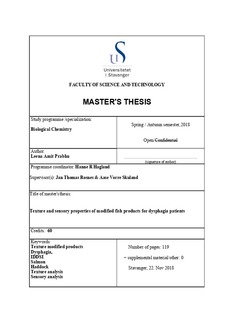| dc.description.abstract | The Statistics Norway (SSB) population projection indicates that the people aged 70 years and above will double in three decades, from nearly 600,000 today to around 1.2 million. During ageing, many elderly people undergo problems with normal swallowing process. This causes swallowing disorder, medically termed as dysphagia. Dysphagia leads to undernutrition and malnutrition that may be followed by prolonged hospital stay and convalescence. Few food products categorized with a specific texture level are available in the retail market or institutions for dysphagia patients.
The main objective of this thesis was to develop two texture modified fish products of soft and pureed consistency of level 4 as per the International Dysphagia Diet Standardisation Initiative (IDDSI) with a high protein content and appealing sensory properties. Fatty fish (salmon) and lean fish (haddock) were used as raw material. Heat treated fish muscle was blended and a new product was reconstructed using texture modifiers, whey and casein proteins, and in addition, enzymatically derived fish hydrolysate. Texture analyses were performed to analyze the effect of modifying the raw material with proteins on the firmness of product. The qualitative aspect after modification was analyzed using qualified sensory panels at Stavanger and Ås.
After a satisfying product was developed, a shelf-life study was performed, intended for a chilled chain distribution for >30 days. The products were pasteurized and packaged in plastic trays with modified atmosphere (100% N2) and autoclaved to a core temperature of 95°C for 15 mins, chilled in ice slurry and stored at 4°C for 4-6 weeks. Texture analyses, sensory analyses and microbiological analyses (aerobic plate count, aerobic and anaerobic spore-formers) were carried out during this storage period. Both salmon and haddock products were compared with the commercially available dysphagia products.
The texture analyses showed that the modified salmon and haddock products with fish protein hydrolysate were softer in texture compared to the products without fish protein hydrolysate, and softer than the commercial reference product. The objective instrumental analyses were compared with the standard test methods described in the IDDSI. Similar results for softness were obtained with a simple IDDSI fork test method. The qualitative descriptive analysis of salmon products and the reference product showed that the attributes within odour (spice and fish odour), appearance (uniformity, dotted and glossy), taste (spiciness and fish taste) and texture (softness, fattiness, granularity, cohesiveness and adhesiveness) were significantly different (p<0.05). The haddock products and the reference product showed significant difference (p<0.05) in the attributes within odour (milk and fish odour), appearance (uniformity, dotted and glossy), taste (saltiness, milky taste, spiciness and fish taste) and texture (hardness, fattiness, fibrous, juiciness, cohesiveness and adhesiveness). The shelf life study of salmon and haddock products at 4°C indicated a good microbiological quality product and safety in 43 days. | nb_NO |

